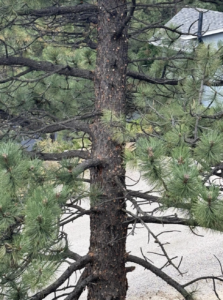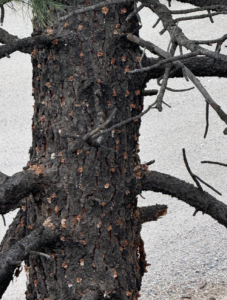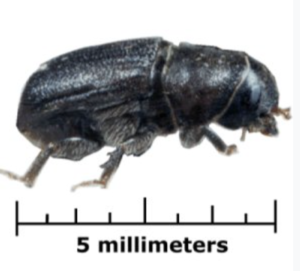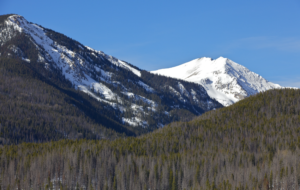Mountain Pine Beetle Treatment
Have you recently discovered Mountain Pine Beetles? Contact us immediately before these destructive pests can continue spreading. We have multiple college degrees and multiple ISA-certified arborists on staff, making us the most educated and experienced pest experts in Denver for handling this issue, and we will work with you to treat the problem before it worsens.
What is the Mountain Pine Beetle?
With recent dry and drought conditions in our Foothills (Conifer, Bailey, and Evergreen) this native insect has once again resulted in the decline and loss of pine trees. It attacks four species, while one species is not native to our local Foothills, the Scotch Pine. The remaining three are Ponderosa Pine, Lodgepole Pine, and Limber Pine. Our Foothills are forested with old growth Ponderosa and Lodgepole pines, while Limber pines prefer a little more elevation.

 They are currently attacking trees in groups, while spreading throughout the hills like wildfire. With our current dry conditions, the beetles are quickly proliferating, and trees are not able to manufacture enough pitch (Sap) to kick the insect out. Once the female is inside the host she will lay her eggs, that will have into larvae that create tunnels as they feed upon the vascular tissues of the tree. The larvae produce glycerol that assists them in surviving the winter months. As temperatures rise in the spring and the tree’s sap starts to flow again, the larvae will begin feeding until they pupate to become adult beetles. Adult beetles begin to emerge in June, with July being the biggest emergence month. They will continue to slowly emerge until sometime in September (as not all eggs, larvae and pupae mature at the same rate). The insect has a one-year life cycle (meaning they produce one generation per season). These beetles are related to IPS Engraver Beetles and can carry the pathogen, Blue Stain Fungi on their mouthparts and transmit it into the host tree upon entering. This Blue Stain Fungi clogs up the vascular tissue within a tree slowing the movement of nutrients and water vital to a tree’s survival.
They are currently attacking trees in groups, while spreading throughout the hills like wildfire. With our current dry conditions, the beetles are quickly proliferating, and trees are not able to manufacture enough pitch (Sap) to kick the insect out. Once the female is inside the host she will lay her eggs, that will have into larvae that create tunnels as they feed upon the vascular tissues of the tree. The larvae produce glycerol that assists them in surviving the winter months. As temperatures rise in the spring and the tree’s sap starts to flow again, the larvae will begin feeding until they pupate to become adult beetles. Adult beetles begin to emerge in June, with July being the biggest emergence month. They will continue to slowly emerge until sometime in September (as not all eggs, larvae and pupae mature at the same rate). The insect has a one-year life cycle (meaning they produce one generation per season). These beetles are related to IPS Engraver Beetles and can carry the pathogen, Blue Stain Fungi on their mouthparts and transmit it into the host tree upon entering. This Blue Stain Fungi clogs up the vascular tissue within a tree slowing the movement of nutrients and water vital to a tree’s survival.
Signs and Symptoms of the Mountain Pine Beetle include:
- Large pitch tubes that are creamy to pinkish in color.
- Dust remnants around bore holes and at the base of the tree.
- Needles (Foliage) will turn from healthy green to yellow, and eventually a fiery-orange color (This may take up to 10 months), resulting in tree death.
- If the bark is removed from an infested or suspect tree galleries and larvae of Mountain Pine Bark Beetle can be found.
- Blue Stained Sapwood can be found.
We are just at the beginning of what may become an epidemic in our Foothills of Mountain Pine Bark Beetle. This means that the area will be looking at catastrophic losses of old growth pine trees.
Property owners in the infested or potentially infested areas are encouraged to contact Bailey Tree today for their free estimate!
We will visit the site and assist the property owner in determining the best and most economical means of moving forward with a treatment plan for the site. Not all trees can or will be able to be treated due to the terrain and access, however we will be able to put together a preservation plan for the canopy of the property. Treatment is completed once a year in the spring.


